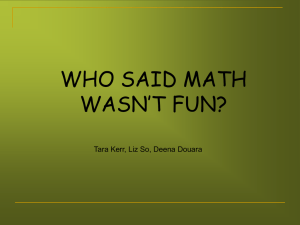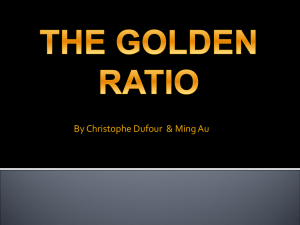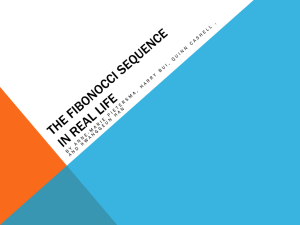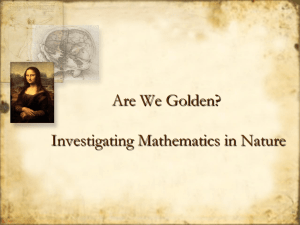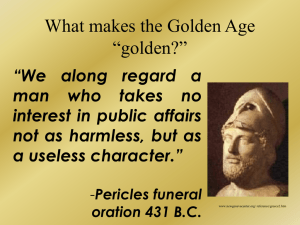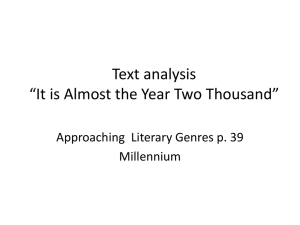Proportion & Scale
advertisement
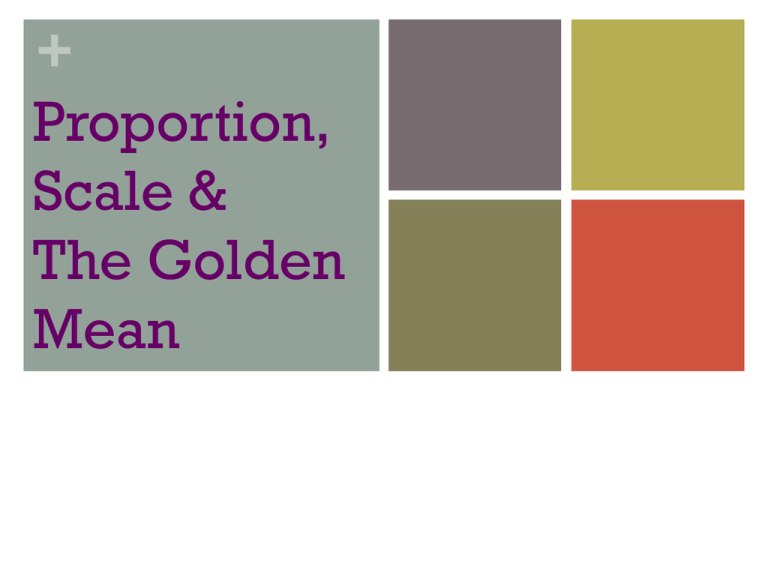
+ Proportion, Scale & The Golden Mean Scale vs. Proportion Scale = Size Proportion = relative size, the size of an object as measured in comparison to another object or against some mental norm or standard. Richard Roth Untitled. 1983. Installation: sphere with red stool. + PROPORTIO N The comparative relationship of one part to another. Gustave Caillebotte + Scale Refers to size as measured against a standard reference. Claes Oldenburg and Coosje van Bruggen Spoonbridge and Cherry 1985-88 Hierarchical Proportion: Using Scale and Proportion for Emphasis Hierarchical Proportion: when figures are arranged in a work of art so that scale indicates importance. For Example: A King, Jesus, Saint or the Pope would be bigger than surrounding people. Large scale can make for a very obvious focal point, or create visual emphasis. Saint Lawrence, a deacon of the Church under Pope Sixtus II (257–58), is shown enthroned, his feet resting on the grill on which he was martyred. He is flanked by Saints Cosmas and Damian, whose cult was closely associated with the ruling Medici family. The Florentine patrician Alessandro Alessandri (1391– 1460) kneels in devotion, facing his sons Jacopo (1422–1494) and Antonio (1423–after 1480). Fra Filippo Lippi (Italian, Florence ca. 1406–1469 Spoleto) Saint Lawrence Enthroned with Saints and Donors Tempera on wood, gold ground Using Scale to Effect Mood An artist can use scale and proportion to create an emotional effect in the viewer. Compare and Contrast these two images. Domenico Ghirlandaio. Last Supper. c. 1480. Fresco, 25ユ 7” (8 m) wide. San Marco, Florence. Emil Nolde. The Last Supper. 1909. Oil on canvas, 2ユ 10 5/8” 3ユ 6 1/2” (88 108 cm). Statens Museum for Kunst, Copenhagen. + Sometimes artists chose to distort or exaggerate the proportions of the subjects involved. Fernando Botero, A Family + Exaggeration & Distortion Deviations from expected, normal proportions. For instance, parts of the human body can be lengthened, enlarged, bent, warped, twisted, or deformed to express certain moods or feelings. Ernst Ludwig Kirchner Erna with Cigarette 1930 + • • • • What Is The Golden Mean? The Golden Ratio The Divine Proportion The Golden Rectangle The Golden Section What Is It? A Golden Rectangle is based on the concept that a rectangle that is 1.6 times as long as it is tall can be divided into perfect sections that can be broken into that ratio 1:1.6 again and again. + The Golden Mean The golden ratio is 1·618034. It is often represented by a Greek letter Phi Φ. The Fibonacci numbers are 0, 1, 1, 2, 3, 5, 8, 13, ... (add the last two to get the next) The golden ratio and Fibonacci numbers relate in such that sea shell shapes, branching plants, flower petals and seeds, leaves and petal arrangements, all involve the Fibonacci numbers. + The Golden Mean and the Human Body The Ancients Knew! The Origins of the Golden Mean are lost to us, but we know that the Egyptians used the idea to build the pyramids. The Pyramids at Giza were built more than 4,500 years ago using the ratio of 1.6 to 1. Meaning that they are 1.6 times a high as they are wide. The Greeks In 477, the Greek city state of Athens built the famous temple to Athena, known as the Parthenon. It’s dimensions are a perfect Golden Rectangle. Devine Proportion Leonardo Da Vinci (1452-1519) studied both art and science. He saw that nature used the“divine proportion” Leonardo saw that humans were proportioned using the same ratio. So he copied it in his artwork. Leonardo did an entire exploration of the human body and the ratios of the lengths of various body parts. “Vitruvian Man” illustrates that the human body is proportioned according to the Golden Ratio. Art of Leonardo Da Vinci Da Vinci incorporated the golden mean in The Mona Lisa and The Last Supper The Rule of Thirds The modern rule of thirds comes from the principle of the golden mean as a useful method to determine where to place or organize objects in a composition. The French impressionist painter Georges Pierre Seurat attempted to incorporate the rule of thirds in all his works. Foreshortening Foreshortening is to shorten and object in a twodimensional composition to make it appear as if it extends backward into space. It gives the illusion of depth and perspective and is often used when depicting the human form in art. ANDREA MANTEGNA Dead Christ ("the foreshortened Christ"), mourned by the Virgin, a pious woman and Saint John Apostle, ca. 1480 Tempera on canvas 26 4/5 × 31 9/10 in 68.1 × 81 cm + Variety, Emphasis, Harmony, & Unity + VAR IE Marc Chagall Y T The use of differences and contrast to increase the visual interest of the work. Variety is achieved when the art elements are combined in various ways to increase visual interest. For instance, an assortment of shapes that are different sizes attracts more attention than an assortment of shapes that are all the same size. Variety Variety is a way of combining elements to create interesting relationships. Artists use this principle when they want to increase the visual interests of their works. Variety is the principle of art concerned with difference or contrast. Note the different contrast of patterns, and textures in the painting by Max Weber. Max Weber Chinese Restaurant 1915 oil + Let’s look at Kandinsky’s painting. How is the artist showing variety in this work? + Variety-a principle of art that is concerned with contrast or difference. Robert Rauschenberg, Trophy II, 1960 + Emphasis & Focal Point The principle of design that makes one part of a work dominant over the other parts. The element that is noticed first is called the dominant or focal point, the elements noticed later are called subordinate. Emphasis is meant to catch the viewer’s attention. Usually the artist will make one area stand out by contrasting it with other areas. The area can be different in size, color, texture, shape, etc. Roy Lichtenstein + Ways to Create a Focal Point Contrast: incorporating an element that contrasts with the rest of the composition. Isolation: putting one object alone, apart from all the other objects. Location: placing an object near the middle of the composition. Convergence: when many elements in a work seem to point to one item. The Unusual: an object that is out of the ordinary. ASIS + EMPH Jim Dine Gustav Klimt +Where is the focal point in Wassily Kandinsky’s, Composition VII ? + Emphasis Or FOCUS in an artwork Edward Hopper American, 1882-1967 Nighthawks, 1942 Oil on canvas + Where are your eyes drawn to first? Next? Then? Where is the focal point of this image? The Conversion of St. Paul, Caravaggio + Does this painting have a focal point? Lavender Mist, Jackson Pollock + Contrast A design principle that emphasizes differences between the art elements. Salvador Dali Ansel Adams + Unity The quality of wholeness or oneness that achieved through the effective use of the elements and principles of art. Degas + Unity Unity is created by simplicity, repetition, and proximity. Marcel Duchamp Nude Descending a Staircase, No. 2 1912. Oil on canvas. + What do you think Cezanne used to keep this painting, Mt. Victoria, unified or working together? + UNITY & Harmony When all the elements and principles work together to create a pleasing image. Johannes Vermeer + Harmony The principle of art that creates unity by stressing the similarities of separate but related parts. Jasper John’s map of the United States could be pulled apart, but it is unified by the harmonious limited color palette, or color choice. Jasper Johns, Map, 1961
